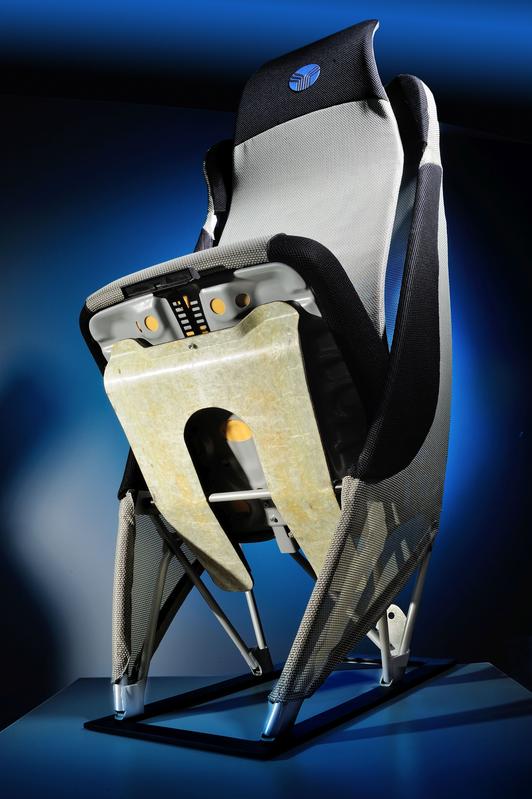Lasers are the key to mastering challenges in lightweight construction

Truck seat in lightweight design, which is up to 20 kg lighter than conventional seats, partly thanks to the seat base made of glass-fiber-reinforced plastic, developed at Fraunhofer ILT © Fraunhofer ILT, Aachen
Lightweight construction materials are popular: aluminum is used in the bodywork of cars, for example, and aircraft fuselages already consist in large part of light carbon composite materials. However, the possibilities of lightweight construction technologies are far from exhausted.
New manufacturing and processing methods are capable of making production processes even faster and of making materials even lighter and more robust. Laser technologies have a particularly important part to play here, as several exhibits from the Aachen-based Fraunhofer Institute for Laser Technology ILT will demonstrate during the LASER World of Photonics. A row of letters two meters high spelling out the word “light” is the most eye-catching exhibit.
The letters are made from a complex, porous mesh structure. Just as it made this special exhibit from plastic using 3D printing technology, Fraunhofer ILT works with industrial customers to develop and manufacture metallic components that are weight-optimized thanks to their internal structure. 3D printing makes it commercially viable to produce even customized and one-off components and tools. The LIGHT legend at the trade fair is a spectacular illustration of how lightweight stable structures can be.
Light and stable thanks to selective laser melting
Manufacturing metallic components with similarly lightweight structures is Fraunhofer ILT researchers’ specialty. To do it, they use the selective laser melting (SLM) method, which has been further developed over the past few years. Broadly similar to 3D printing, SLM involves using a laser beam to melt powder with pinpoint accuracy according to CAD data instructions.
This melt then hardens to form layers of just a few micrometers in thickness, building up a component layer by layer. The researchers also used SLM methods to develop a stable and very lightweight control arm support for a sports car, from which the wheels are individually suspended. This control arm, too, has a hollow structure inside, making it both lighter and more stable than cast or machined components. Hollow structures of that complexity would be impossible to produce without SLM methods.
Sticking materials together without adhesive
Making components and vehicles ever lighter is a challenge, because the weight savings must not come at the expense of stability. For this reason, today’s lightweight construction often combines different materials – such as aluminum and fiber-reinforced plastic (FRP) – each chosen for its suitability for a specific purpose. As the stability of FRP suffers when it is screwed together with other components, current practice is generally to glue the various materials together.
However, this means adding a third material to the equation – one that can also age and crack. Fraunhofer ILT scientists’ answer to these drawbacks when joining FRP and metal is to employ laser-based processing techniques. In this case, they use a laser to burn a 100-micrometer-scale pattern into the surface of the metal component with small depressions and undercuts.
“When joining metal and FRP this way, the plastic flows into the depressions while it is still hot and liquid,” explains ILT laser expert Dr. Alexander Olowinsky. “When the plastic hardens, it is anchored into the surface of the metal.” A plastic-reinforced car door that was manufactured using this method will be on display at the trade fair.
These days, people are increasingly combining not only FRP and metal with each other but also – depending on the application – various kinds of steel. In order to bring down vehicle weight, automakers are now making use of materials such as high-strength, press-hardened steels. These are particularly stable, meaning thinner sheets can be used, which reduces weight.
But they are also expensive, prompting automakers to weld conventional steels together with high-strength, press-hardened steels. The problem is that standard methods such as spot welding cause the strength of the high-strength steels to diminish at the joint.
To address this situation, Fraunhofer ILT worked with several industrial partners in a cooperative project to develop an alternative welding method that does not impair the crash stability of the high-strength steels. During the trade fair, the researchers will be presenting the different technologies by means of various exhibits such as the control arm support.
The researchers will also be presenting the exhibits at the Fraunhofer media tour on Tuesday, June 23, 2015. It starts at 11:00 a.m. at Booth 341 in Hall B3 and ends at approximately 12:00 midday at Booth 121 in Hall A3, followed by a discussion and light refreshments.
Contact
Dr.-Ing. Alexander Olowinsky
Head of the Micro Joining Group
Telephone +49 241 8906-491
alexander.olowinsky@ilt.fraunhofer.de
Fraunhofer Institute for Laser Technology ILT
Media Contact
All latest news from the category: Trade Fair News
Newest articles

Parallel Paths: Understanding Malaria Resistance in Chimpanzees and Humans
The closest relatives of humans adapt genetically to habitats and infections Survival of the Fittest: Genetic Adaptations Uncovered in Chimpanzees Görlitz, 10.01.2025. Chimpanzees have genetic adaptations that help them survive…

You are What You Eat—Stanford Study Links Fiber to Anti-Cancer Gene Modulation
The Fiber Gap: A Growing Concern in American Diets Fiber is well known to be an important part of a healthy diet, yet less than 10% of Americans eat the minimum recommended…

Trust Your Gut—RNA-Protein Discovery for Better Immunity
HIRI researchers uncover control mechanisms of polysaccharide utilization in Bacteroides thetaiotaomicron. Researchers at the Helmholtz Institute for RNA-based Infection Research (HIRI) and the Julius-Maximilians-Universität (JMU) in Würzburg have identified a…



